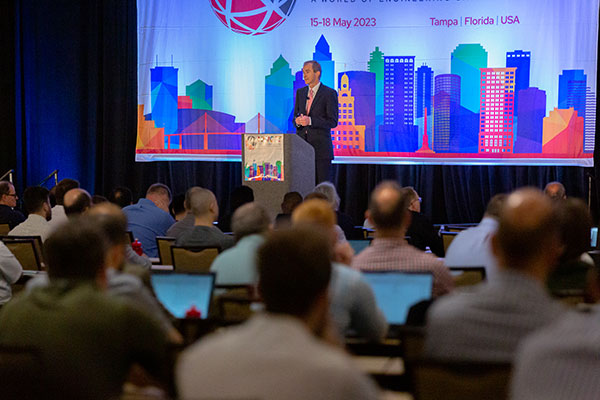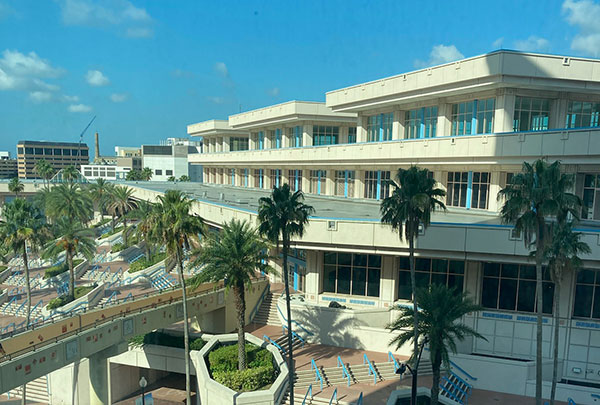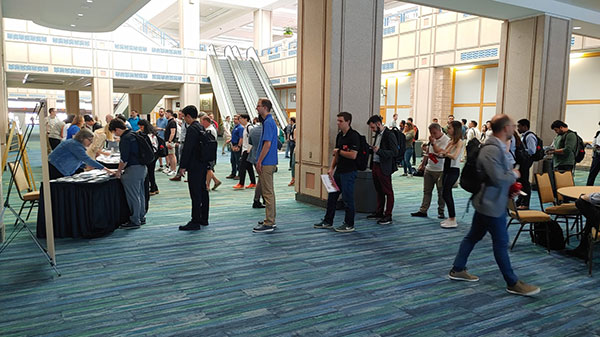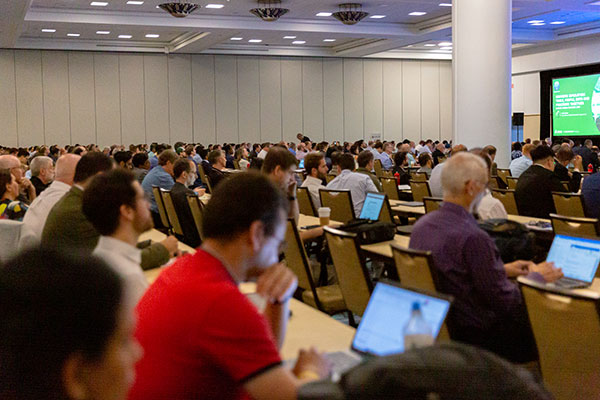
Tim Morris, CEO of NAFEMS, opens up the NAFEMS World Congress 2023 in mid-May at the Tampa Convention Center in Florida. Image courtesy of NAFEMS.
Latest News
June 9, 2023
NAFEMS World Congress 2023, a simulation community of members now 40 years in existence, convened at the Tampa Convention Center in Florida, near the city’s picturesque riverwalk, for its first in-person event since the COVID-19 pandemic. Attendance turned out better numbers than anticipated, with around 560 people from around the world in the Sunshine State to participate in any of 352 presentations, 15 workshops, 13 short courses and 7 keynotes. When not gathering knowledge passively, attendees had ample opportunity to network with any of 37 vendors.
Leadership on the opening morning invited attendees to make the most of NWC 23 and “act lively” at the event. In his opening remarks, Tim Morris, CEO of NAFEMS, called on the audience to ask themselves three questions: Why do you get involved in engineering simulation? What can NAFEMS do for you? Why are you attending NWC 23?
Sessions were engaging, with plenty of thoughtful questions from the audience. Even the less-attended sessions were interactive, including one on on-premise vs. cloud HPC. The animated back and forth from vendors and end users demonstrated in a small way that people were serious about in-person interaction.
“It’s an absolutely brilliant barometer of what is going on,” Ian Symington, NAFEMS’ chief technical officer, said of the NWC 23 event. “You’ve got the vendors out there and they’re selling methods. When we see what’s actually being done by the engineering organizations, it really shows us what is really being used. So it’s a good temperature check on what the state of the industry is,” he says.

What’s on Tap?
Some hot topics, probably not surprising, included artificial intelligence, democratization of simulation, noise vibration harshness in vehicles, additive manufacturing and simulation, simulation process data management, various angles on HPC, historical lookbacks (history of the Boeing 747, CFD in the past 100 years), applications of machine learning using simulation data, simulation of electric vehicles, simulation’s role in autonomous driving, industry collaborations, digital twin applications in simulation—and the twin’s expansion into newer markets, including agriculture, construction, and even consumer packaged foods (such as cereal maker General Mills), to name a dozen or so.

“One of the [topics that] is coming across strongest at the moment—there has been a shift in the last 5-7 years—everybody is interested in AI. That’s not a big thing. But, that has clearly gone from hype to people trying to use it,” Symington said. His words rang true as sessions covered everything from physics-driven AI to drive design to AI-aided design optimization to computational engineering and AI-accelerated R&D in the cloud, just to name a few sample session topics.
ASSESS Gaining Traction
ASSESS, dubbed the “thinktank of NAFEMS,” also helped open the event, providing an informed update to engage new NAFEMS members. Walsh noted in passing that efforts are beginning to pay off with the ASSESS/NAFEMS collaboration and inroads are being made in this segment of the simulation community.
“The simulation revolution is about making engineering simulation widely available and appropriate to support improved decision making through the entire lifecycle of engineered products and processes.” Joe Walsh explained.
“We’re beginning to see awareness that this is something different that could be beneficial,” he continued. “And people are understanding what it is that ASSESS does that is complementary and different from what the rest of NAFEMS is. NAFEMS’ focus is best described as best practices, including training and techniques. ASSESS is all about answering, ‘What is the next thing we should be thinking about?’ It’s about strategies and futures. How do we create the future we want for simulation rather than just living with what happens?”
“ASSESS isn’t about our dictating what the future thoughts are. It’s about selecting enough people who think about these sorts of things and curating their thoughts and sharing those with others,” Walsh added.
Survey Says…
Also during the opening keynote session, Alessandro Faure Ragani of McKinsey & Company focused on the McKinsey survey of the future of engineering simulation. Ragani specifically shared key insights from the simulation-oriented survey of NAFEMS membership that included approximately 200 responses. Some highlights mentioned were:
- “Greater than 70% of organizations consider faster time to market and reduced product cost as key future value drivers for the simulation market,” Ragani shared.
- “Ten times more companies use classical simulation instead of AI/ML-based simulation at a high maturity level yet two out of three organizations are experimenting with AI/machine learning for simulations at least in pilot projects,” he noted.
- Disruption by industry: “Simulation users within automotive are 1.6 times more likely to use AI/ML based simulations compared to users in machinery production,” Ragani added.
- He also mentioned some industry impediments: “Three out of five organizations consider a shortage of talent and limited understanding of benefits as a critical impediment toward adoption of AI/ML based simulation.”
Later in the opening sessions, Mark Bohm of Dassault Systèmes started his keynote off in jest. He sought to answer the question that Tim Morris had previously raised about why he was at NAFEMS.
“Two words: ‘Zoom fatigue,’” he joked. “Truly, it’s very nice to see people in person—old friends and hopefully new. The reason I got into simulation,” Bohm says in answering another of Morris’ questions, “was I loved math and physics, and engineering. But the reason I stayed in simulation was the people, both within my company and customers I work with. It’s quite a diverse group of people all over the world. The way they tackle problems in engineering using math and science—it’s always interesting.”
He set the stage for the more technical content of the conference. He says what his company sees within Simulia echoes the results of the survey. “Organizations are prioritizing time to market – we’re validating that survey result,” he said. “End users need to do work more efficiently and easily.” Underlying the various drivers is “the need to innovate in a sustainable way. You can’t assume last year’s product will work next year. Simulation is really an enabler to innovation,” Bohm said, “which is what keeps us engaged and interested in what we love doing.” He then gave a brief snapshot of Dassault offerings and how these products can enhance simulation for end users.
A bonus highlight from the first day’s sessions was a keynote from Steve Chisholm of Boeing Boeing on the history of the iconic Boeing 747. He opened his talk by lightheartedly noting how he put ChatGPT to the test. He said he tested out ChatGPT by stating, “I believe the 747 is truly the most iconic airplane.” He said, “It agreed with me so I feel validated now.”
His session took a look back at the plane first introduced in 1965, with its last delivery of a 747 occurring on January 31 of this year. He discussed the weight challenges with the plane, payload, and even FEA acronyms from the 747 era.
“The 747 was empowered by analysis and simulation. Since the 60s, every aerospace vehicle was analyzed in part by FEA,” he noted.
Chisholm showed a documentary of the mid-60s of the making of the 747, noting the old film’s major takeaway—“weight is key.” The weight problem highlighted in the documentary “required some in-depth work. It’s in-depth engineering work. What do engineers do to solve a problem? They look at more sophisticated ways of assessing it. In this case, it was finite element analysis.”

After the keynotes, attendees could visit any of about a dozen tracks throughout the day, hopping in on sessions of greatest practical benefit to them. NAFEMS' Symington said he spent some time popping in and out of sessions to see what was drawing the most people.
“I like to see the busy sessions,” he said. Symington also noted the value of “getting simulation used by people who traditionally wouldn’t use it, dare I say non-experts. It’s not really non-experts, but people who haven’t traditionally used simulation before. People in marketing, people trying to sell products. Caterpillar, for example, is making strides pushing simulation further in their organization.” He also mentioned biomedical as another field is working to solve simulation issues within its space.
A Visit to the Exhibits
On the show floor, vendors were highlighting a variety of “new-ish” products, ranging from multi flexible body dynamics simulation software to data-based modeling tools to physics-based machine learning and AI algorithm to managed HPC for CAE tools, though to the editor’s knowledge, none were hot-off-the-press announcements at NAFEMS. Vendors included Dassault Systemes, Hexagon, NVIDIA, Microsoft Azure, Ansys, Cadence, Rescale, Siemens, TotalCAE, 3M, AMD, Penguin Computing, BETA CAE Systems, Coreform, Predictive IQ, EASA, ESTECO and several others.
In summing up the event, Symington said, “NAFEMS has come back quite strongly so it doesn’t feel too different. It feels like a return to normality.
“As a Congress, we can be quite reactive,” he added. “The Congress demonstrates what is going on in the simulation community. Our membership—the people who come here—they’re real engineering companies. When we’re looking to put the agenda together, it really reflects what those organizations are using simulation technology for.”
As for where NAFEMS is headed, Symington added the goal remains to have “simulation even more widely used” than it is today.
More NAFEMS Coverage
Subscribe to our FREE magazine, FREE email newsletters or both!
Latest News
About the Author
Stephanie is the Associate Editor of Digital Engineering.
Follow DE





